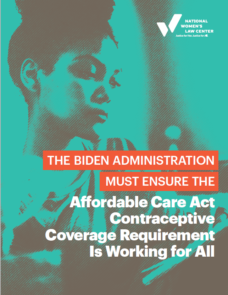
 The Affordable Care Act’s (ACA) contraceptive coverage requirement—the provision that guarantees no-cost coverage of the full range of birth control methods—has significantly expanded access to birth control. As of fall 2020, because of this requirement, 64.3 million women had insurance coverage that includes contraception without cost-sharing. This coverage has translated into significant benefits to people’s economic security, health, and well-being. Without out-of-pocket costs as a barrier to preventive services, people are better able to access the care they need. Despite the enormous gains of the contraceptive coverage requirement, not everyone is receiving the coverage they are guaranteed by law. The National Women’s Law Center continues to hear reports of violations among insurance plans that should be covering birth control without out-of-pocket costs. These violations leave people to pay out-of-pocket for the birth control they need, push them into using a method that is not right for them because of cost, or cause them to forego contraception altogether. These non-compliant plans are reinstating the very barriers to contraception that the ACA’s preventive services provision sought to remedy. The federal agencies that oversee the ACA contraceptive coverage requirement must take action to ensure plan compliance with the law and guarantee that the promise of the contraceptive coverage requirement is met for everyone. Strong leadership at the federal level can make a difference.
The Affordable Care Act’s (ACA) contraceptive coverage requirement—the provision that guarantees no-cost coverage of the full range of birth control methods—has significantly expanded access to birth control. As of fall 2020, because of this requirement, 64.3 million women had insurance coverage that includes contraception without cost-sharing. This coverage has translated into significant benefits to people’s economic security, health, and well-being. Without out-of-pocket costs as a barrier to preventive services, people are better able to access the care they need. Despite the enormous gains of the contraceptive coverage requirement, not everyone is receiving the coverage they are guaranteed by law. The National Women’s Law Center continues to hear reports of violations among insurance plans that should be covering birth control without out-of-pocket costs. These violations leave people to pay out-of-pocket for the birth control they need, push them into using a method that is not right for them because of cost, or cause them to forego contraception altogether. These non-compliant plans are reinstating the very barriers to contraception that the ACA’s preventive services provision sought to remedy. The federal agencies that oversee the ACA contraceptive coverage requirement must take action to ensure plan compliance with the law and guarantee that the promise of the contraceptive coverage requirement is met for everyone. Strong leadership at the federal level can make a difference.
